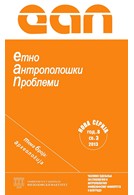Čitanja Miloja M. Vasića u srpskoj arheologiji
Images of Miloje M. Vasić in Serbian Archaeology
Author(s): Aleksandar PalavestraSubject(s): Archaeology, Cultural history, Recent History (1900 till today), Methodology and research technology
Published by: Филозофски факултет, Универзитет у Београду
Keywords: Miloje M. Vasić; history of the discipline; Serbian archaeology; reception of ideas; archaeological material; authority; fieldwork;
Summary/Abstract: Miloje M. Vasić, "the first academically educated archaeologist in Serbia", has a strange destiny in the Serbian archaeology. On the one hand, he has been elevated to the post of the "founding father" of the discipline, with almost semidivine status and iconic importance, while on the other hand, his works have been largely unread and neglected. This paradoxical split is the consequence of the fact that Vasić has been postulated as the universal benchmark of the archaeological practice in Serbia, regardless of his interpretation of the past on the grounds of the archaeological record – the essence of archaeology. Strangely, the life and work of Vasić have not been the subject of much writing, apart from several obituaries, two short appropriate texts (Srejović, Cermanović), and rare articles in catalogues and collections dedicated to the research of Vinča (Gara- šanin, Srejović, Tasić, Nikolić and Vuković). The critical analysis of his whole interpretive constellation, with "The Ionian colony Vinča" being its brightest star, was limited before the World War II to the rare attempts to rectify the chronology and identify the Neolithic of the Danube valley (Fewkes, Grbić, Holste). After the war, by the middle of the 20th century, the interpretation of Vasić has been put to severe criticism of his students (Garašanin, Milojčić, Benac), which led to the significant paradigm shift, the recognition of the importance of the Balkan Neolithic, and the establishment of the culture-historical approach in the Serbian archaeology. However, from this moment on, the reception of Vasić in the Serbian archaeology has taken a strange route: Vasić as a person gains in importance, but his works are neglected, though referred to, but almost in a cultic fashion, without reading or interpreting them. Rare is a paper on the Neolithic of the Central Balkans that does not call upon the name of Vasić and his four-volume "Vinča", in which Neolithic is not mentioned at all. This paradox becomes clearer if Vasić is regarded through the prism of the problematic, but not yet challenged and universally praised values in the Serbian archaeology: material, fieldwork and authority, as opposed to interpretation, which is regarded as ephemeral. From this point of view it becomes clear how the image of Vasić grows into the icon of the Serbian archaeology, while his work slides into the domain of the oral tradition, half-truths, and apocryphal anecdotes. Considering that the majority of the Serbian archaeological community shares the belief that there is an absolute archaeological method and "pure" archaeological material, both representing "the data not burdened by theory", the field journals of Vasić and his published works become the source of the "material", while his interpretation of the past is neglected. As long as these "data" are not considered in connection to the whole opus of Vasić, the research questions and strategies that directed his work, the Serbian archaeology will be inhabited by two separate images: one – forefather and founder, the researcher of the Neolithic Vinča, "the first real Serbian archaeologist", whose face gazes at us sternly from the bronze busts and enlarged photographs, and the other – vulnerable and insulted dreamer, convinced in his philhellene delusion. Only the integration of these two images will pay due homage to Miloje M. Vasić.
Journal: Етноантрополошки проблеми
- Issue Year: 8/2013
- Issue No: 3
- Page Range: 681-715
- Page Count: 35
- Language: Serbian

